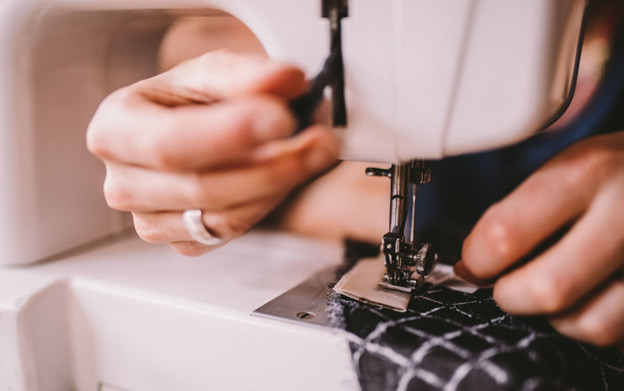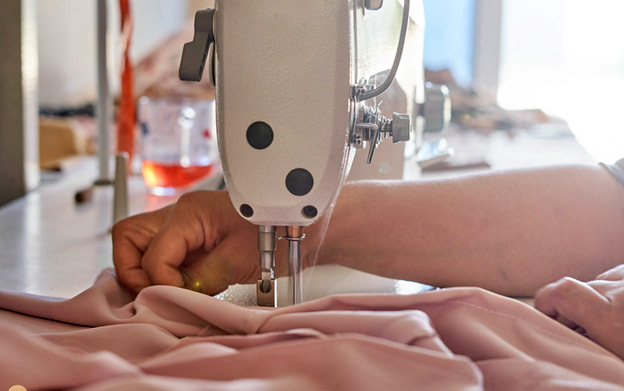Get Off the Fast Fashion Train: Exploring Fabric Options for Handmade Garments
Shopping for clothes, a bitter-sweet dive for the perfect pieces in a vast sea of options. Garments often cling where they shouldn’t and gape where they ought to hug - almost everyone has some kind of a love-hate relationship with the fitting mirror. But while you stand there, bathed in a harsh, unflattering light, holding back an exasperated sigh, try to remember that it’s not you who needs adjusting, it’s the fast fashion narrative.

Built on a one-size-fits-all principle, the world of fast-cycle, cheap chic fashion, paints a narrow picture of beauty, one that forces us to twist and contort to fit into fleeting trends. But underneath the pressure, a rebellion simmers - a rebellion led by the makers, the menders, the upcyclers, and artisans of slow fashion.
Why Is Making Your Own Clothes Good?
Is it worth it to make your own clothes? Turning raw materials into garments takes skill, time, and effort. It may not be an easy process, but it’s indeed one packed full of benefits.
Perfect Fit Every Time

Sewing your own clothes means no more settling for “close enough”. You get to create clothes that move with you, feel comfortable all day long, and boost your confidence with every wear. You can use patterns or draft your own to tailor every piece to your body shape. And if you’re off to a rough start, you can always refine the fit, turning “almost right” into a “made for me”.
Bespoke Style and Comfort

Then, you can choose your clothing fabric from a wide choice of luxurious fibres like breathable and organic cotton, cosy wool, flowing silk and soft linen, to name a few. Not to mention the myriad of textures, colours and patterns available to fuel your creativity. The possibilities are endless, allowing you to express your unique style and feel comfortable in your own skin.
Better for Your Wallet
How many times have you had a garment fall apart unexpectedly due to shoddy stitching or weak seams? And what about those shirts that tear, shrink, and lose colour after a few washing cycles? While buying garment fabrics may seem expensive at first, you should think about how much you would actually save in the long run with high-quality, tailored clothes that last for years.
Kinder to the Environment

And that leads us to the next point, cheap, ruined clothes, adding unnecessary strain to the already overburdened landfill, fuelling the climate crisis. By making your own clothes, you can break away from the disposable fashion chain and become a part of the solution.
With that being said, it’s time to explore the different fabrics for clothing that’s both sustainable and soulful.
Natural Fabrics
When comfort and durability are top priorities, look no further than natural fibres like cotton, linen, silk, and wool.
An Affordable & Easy to Sew Option
Cotton offers breathability and effortless flow that keeps you cool in the summer yet cosy in colder weather, making it a versatile choice for all-weather wardrobe. And if you’re wondering what fabric is the easiest to work with, cotton is considered a good choice for beginners as it’s one of the most forgiving options out there.
A Summer Staple
Linen boasts feather-like ease and lightweight comfort, perfect for summer wardrobe pieces. One of the best things about this clothing fabric is that it ages gracefully, becoming softer with every wash.
A Winter Wardrobe Must-Have
When it’s time to get nice and toasty, fall into the luxuriously soft embrace of natural wool, the ultimate choice for warmth, breathability, and resilience.
A Timeless Drape and Luxurious Feel

What is so special about silk that makes you instantly think of opulence? Well, nothing really compares to the sensory experience that silk provides. With its luxurious softness, smooth texture, shimmering beauty and elegant drape, it caresses the senses ever so gently for the ultimate indulgence.
In addition, silken materials are incredibly versatile owing to their strength and durability. From gowns and dresses to shirts and blouses, and beyond, you can create various pieces, both for formal and casual wear. However, keep in mind that working with this material can be tricky due to its smooth and slippery texture, so you’ll need to learn to handle it properly.
Synthetic Fabrics
Synthetic fabrics are often frowned upon, but in some cases, they offer advantages over natural fibres. What they lack in breathability and comfort, they compensate with durability, wrinkle resistance, easy care, and shape retention, making them valuable options for outerwear and specialised clothing.
For instance, a tightly woven nylon blend will stand strong against harsh winds and repel water during unexpected showers. While it certainly won’t be as comfortable as your favourite light and breezy linen shirt, it will provide the performance and protection required for certain outdoor activities.
Blended Fabrics
Blended sewing materials combine different fibres to enhance the overall performance or offer additional properties that the original fabric may lack.
For instance, polyester cotton blends combine the best of both worlds. While cotton brings its natural breathability and softness, polyester lends it its wrinkle resistance and durability, making the blend comfortable, easy to care for, and long-lasting.
Cotton and elastane blends are another example of how natural and man-made fibres can produce versatile complementary fabrics, perfect for creating clothes that retain their shape yet add a touch of give for all-day comfort.
Viscose is another semi-synthetic material that mimics the softness and breathability of natural fibres like silk, but with added wrinkle resistance and easier care, making it a practical choice for everyday garments.
Whether you’re tired of the fitting room blues, want to save money on clothing, looking to reduce your footprint, or just interested in taking up a new hobby, you should consider sewing your own clothes. With the needle as your compass and the fabric as your landscape, you can embark on a journey to a tailored wardrobe that’s as unique as you are.
So without further ado, you can now hit your local haberdashery or textile supplier online or in-store and stock up on the essentials for your handmade clothing projects.
Hits: 4213 | Leave a comment

















